A) Frontal
B) Transverse
C) Sagittal
D) Oblique
E) None of these choices
Correct Answer

verified
Correct Answer
verified
Multiple Choice
Which two panels in the figure show a movement of a bone away from the midline of the body?
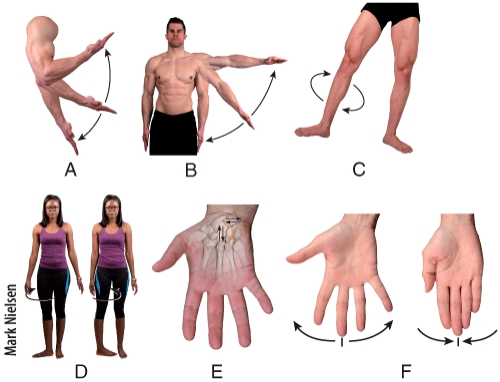
A) A and B
B) B and D
C) D and E
D) F and A
E) B and F
Correct Answer

verified
Correct Answer
verified
Multiple Choice
Moving the humerus laterally at the shoulder joint is an example of which type of movement?
A) Lateral flexion
B) Hyperextension
C) Adduction
D) Abduction
E) Gliding
Correct Answer

verified
Correct Answer
verified
Multiple Choice
Which type of movement involves a continuous sequence of flexion,abduction,extension,and adduction resulting in a distal body part moving in a circle?
A) Gliding
B) Lateral flexion
C) Hyperextension
D) Circumduction
E) Elevation
Correct Answer

verified
Correct Answer
verified
Multiple Choice
Which of the joints shown in the figure only permits back-and-forth and side-to-side movements between the articulating bones?
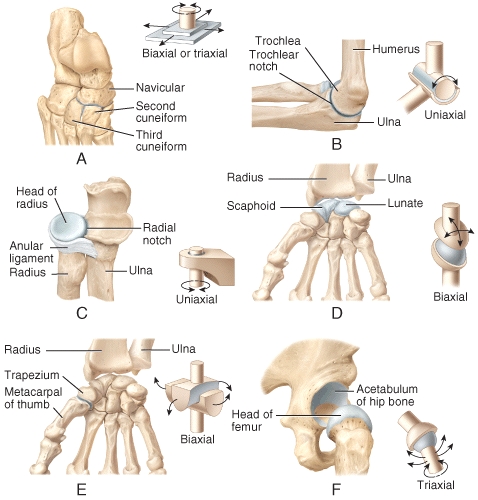
A) A
B) B
C) C
D) Both A and B
E) Both A and C
Correct Answer

verified
Correct Answer
verified
Essay
Briefly describe what is happening when a person "cracks their knuckles".
Correct Answer

verified
When the synovial cavity expands,the pre...View Answer
Show Answer
Correct Answer
verified
View Answer
Multiple Choice
A condyloid joint
A) is also called an ellipsoidal joint.
B) is considered to be biaxial.
C) allows both flexion-extension and abduction-adduction of the joint.
D) can be found in the wrist.
E) is All of these choices
Correct Answer

verified
Correct Answer
verified
Essay
List the three structural categories of joints and briefly describe the criteria used for structural classification of joints.
Correct Answer

verified
The structural types of joints include:1...View Answer
Show Answer
Correct Answer
verified
View Answer
Multiple Choice
In which type of synovial joint does a rounded or pointed surface on one bone articulate with a ring formed partly by another bone and partly by a ligament?
A) Pivot joint
B) Planar joint
C) Hinge joint
D) Ball-and-socket joint
E) Saddle joint
Correct Answer

verified
Correct Answer
verified
Multiple Choice
Bursae are saclike structures that are commonly found between bone and
A) skin.
B) muscle.
C) ligaments.
D) tendons.
E) all the other answer selections.
Correct Answer

verified
Correct Answer
verified
Multiple Choice
Which of the joints shown in the figure only permits back-and-forth and side-to-side movements between the articulating bones?
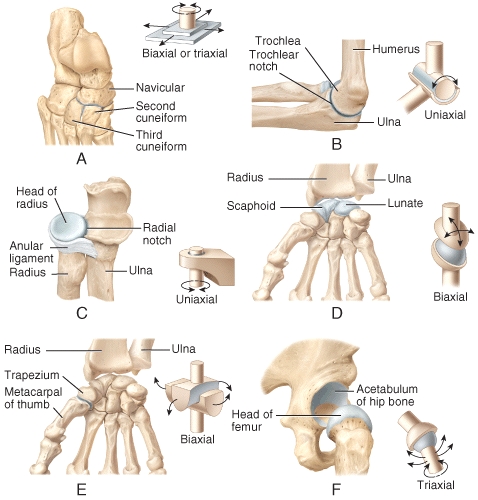
A) A
B) B
C) C
D) Both A and B
E) Both A and C
Correct Answer

verified
Correct Answer
verified
Multiple Choice
What type of special movement occurs in your clavicles at your acromioclavicular and sternoclavicular joints when you cross your arms in front of your body?
A) Protraction
B) Retraction
C) Inversion
D) Eversion
E) Supination
Correct Answer

verified
Correct Answer
verified
Multiple Choice
Which of the panels in the figure shows a movement called lateral flexion?
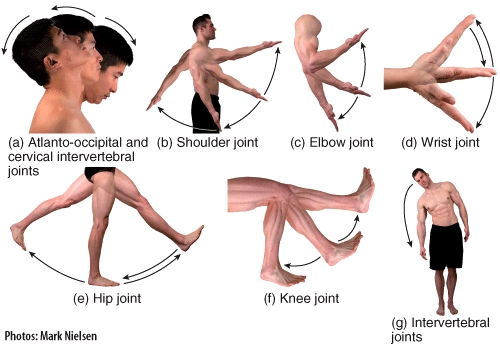
A) B
B) F
C) G
D) D
E) C
Correct Answer

verified
Correct Answer
verified
Multiple Choice
Which of the following is NOT a structural category of synovial joints?
A) Planar
B) Hinge
C) Condyloid
D) Suture
E) Saddle
Correct Answer

verified
Correct Answer
verified
Multiple Choice
Bending the trunk forward at the intervertebral discs is an example of what type of angular movement?
A) Flexion
B) Extension
C) Lateral flexion
D) Hyperextension
E) None of these choices
Correct Answer

verified
Correct Answer
verified
Multiple Choice
Which of the joints shown in the figure is classified as a multiaxial joint?

A) B
B) C
C) D
D) E
E) F
Correct Answer

verified
Correct Answer
verified
Multiple Choice
Which of the following is a type of fibrous joint composed of a thin layer of dense irregular fibrous connective tissue found between the bones of the skull? 1) Syndesmoses 2) Gomphosis 3) Suture
A) 1 only
B) 2 only
C) 3 only
D) Both 1 and 2
E) None of these choices
Correct Answer

verified
Correct Answer
verified
Multiple Choice
Which of the following is an autoimmune disease that affects the joints?
A) gouty arthritis
B) Lyme disease
C) arthroplasty
D) osteoarthritis
E) rheumatoid arthritis
Correct Answer

verified
Correct Answer
verified
Multiple Choice
In the figure,what represents a saddle joint?
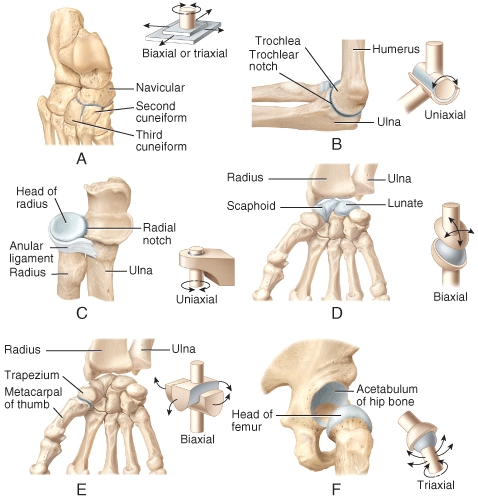
A) A
B) B
C) C
D) D
E) E
Correct Answer

verified
Correct Answer
verified
Essay
List and briefly describe the three common types of arthritis.
Correct Answer

verified
1.Rheumatoid arthritis is an autoimmune ...View Answer
Show Answer
Correct Answer
verified
View Answer
Showing 21 - 40 of 75
Related Exams